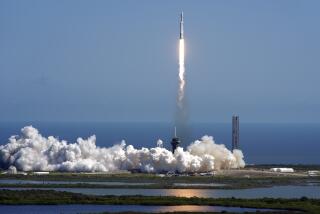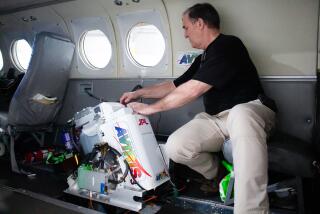NASA’s dangerous Juno mission: Unravel Jupiter’s secrets and solve the mysteries of life

Attention, world: We’re about to arrive at Jupiter. 06/29/2016
- Share via
Late at night, when the halls around her were empty, Heidi Becker positioned her subject in the crosshairs of an electron-shooting linear accelerator. Along with her companions, she arranged a cartload of heavy lead bricks to make sure the deadly radiation would hit only its intended target.
By day, the accelerator at the Curie Institute hospital in Paris was used to kill tumors in cancer patients. This time, its lethal gaze would be aimed at an early version of the star tracker aboard NASA’s Juno spacecraft, which is set to enter Jupiter’s orbit on July 4.
The instrument will play a key role in helping scientists determine Juno’s orientation as it takes billions of high-definition measurements of Jupiter’s punishing magnetic field. At the hospital, Becker and her fellow engineers were doing their best to mimic the lethal forces the star tracker would face. They wanted to be sure that it would survive.
Jupiter “is the scariest place,” said Becker, who leads the mission’s radiation monitoring investigation at NASA’s Jet Propulsion Laboratory. “There isn’t anything like it anywhere else.”
It’s not your typical test for spacecraft parts, but this is no typical destination.
On Monday night, if all goes as planned, Juno will complete its looping, 1.8-billion-mile journey and slip into Jupiter’s embrace — the first spacecraft to orbit the gas giant since NASA’s Galileo satellite last circled its equator in 2003.
The rewards of the $1.1-billion mission are clear: to probe Jupiter’s deeply held secrets and solve longstanding mysteries about the origins of our solar system, of Earth and, by extension, of life itself.
But as it explores the gas giant, Juno will have to fight for its own life.
The craft will fly within 2,600 miles of the planet, closer than any previous satellite. As it completes 37 orbits over 20 months, Juno will have to withstand a brutal onslaught of radiation.
The high-energy electrons around Jupiter are like machine-gun fire: constant and extremely penetrating. After the initial volley, each ricocheting particle releases a spray of subatomic shrapnel that does even more damage.
“Jupiter is really, really hazardous,” said Scott Bolton, Juno’s principal investigator at the Southwest Research Institute. To withstand the barrage of high-energy electrons, most of Juno’s electronics are inside a titanium vault. “We’re an armored tank.”
Like its mythological counterpart, Jupiter is king of its realm: the largest and most powerful planet, more than twice as massive as all the others combined, and the first to be born from the swirling disk of gas and dust that once surrounded our nascent star.
It is also the most sun-like planet: made mostly of hydrogen and helium, with traces of heavier elements thrown in. In fact, size aside, the main difference between Jupiter and the sun is that the planet has a larger share of those trace elements, including carbon, nitrogen and sulfur.
“We don’t know how Jupiter got enriched, but we know it’s very important,” Bolton said. “Because the stuff that Jupiter has more of is what we’re all made out of. It’s what the Earth is made out of. It’s what life comes from.”
Four centuries ago, Galileo Galilei’s observations of the planet and its four largest moons demonstrated that the Earth was not the center of the universe — a discovery that ultimately landed him under house arrest until his death. And yet, large as this storm-eyed, striped giant looms in our minds, we know remarkably little about it.
For example, scientists don’t know if Jupiter’s Great Red Spot, that giant storm that could swallow the entire Earth, is merely an atmospheric phenomenon or a structure that penetrates far into the planet.
Nor do they know how much oxygen or water lies within the planet, a mystery that only deepened after NASA’s Galileo probe plunged into the gas giant in 1995 and found it to be surprisingly dry.
Hydrogen is by far the most abundant element in the universe, and oxygen ranks third. Together, that should have made for a lot of water — that is, if Jupiter really does hold within it the secret recipe for our solar system.
Perhaps the Galileo probe did not reach deep enough. Perhaps it hit a dry spot. Or perhaps scientists’ theories of planetary formation are completely wrong.
“That one single number, the water content, will tell us a whole lot,” said Steven Levin, Juno’s project scientist at JPL in La Cañada Flintridge.
Juno will also be the first mission to orbit the planet’s poles, documenting its powerful northern and southern auroras, studying its colossal magnetic field up close and perhaps learning what exactly powers it. After completing its nearly five-year journey from Earth, the spacecraft will take a highly elliptical orbit, crossing from one pole to the other in just two hours, then shooting far out into space for about two weeks. This will allow researchers to compare their measurements close to and farther from the planet’s influence.
The deepest mystery lies at the heart of the gas giant — scientists want to find out whether it has a hard center, like an inverse Tootsie Pop. Researchers aren’t sure if Jupiter hides a solid core of heavy metals such as iron and nickel, or whether it’s filled with hydrogen that has been compressed so much that its electrons have been squeezed off, allowing it to behave like a metal. If there’s rocky material in the core, it may hint that Jupiter formed later in the solar system’s history, after chunks of rock had time to coalesce out of the dust.
Juno is a giant spinning three-armed pinwheel whose 30-foot-long solar panels make it about the size of a basketball court. So far from the sun, those panels only provide roughly 500 watts of electricity — not enough to power a hair dryer, but perfect for this efficient suite of instruments.
Juno’s infrared spectrometer and ultraviolet spectrograph will study the planet’s auroras in different wavelengths of light. A microwave sensor will use radio waves to search for water and ammonia hidden beneath the thick cloud-tops.
JunoCam, a visible-light camera, will be the first to take close-up pictures of the planet’s poles. The mission team is asking members of the public to help pick interesting targets and process the resulting images.
Though it flies above Jupiter’s atmosphere, Juno will peer deep into the planet. A magnetometer, perched at the end of one solar-paneled arm, will create a 3D map of the planet’s enormous magnetic field, which should shed light on the internal dynamics that power it. Another experiment will map the planet’s interior structure by measuring the tiny shifts in radio signals caused by subtle gravitational tugs that distort the spacecraft’s orbit.
Unlike many NASA missions, Juno’s 20-month investigation probably won’t be extended by much: The spacecraft, armored as it is against Jupiter’s harsh environment, can’t protect its systems indefinitely. And scientists do not want to risk having a radiation-fried satellite go off-course and potentially contaminate a nearby moon like Europa, one of the solar system’s best candidates for finding microbial life.
Ultimately, Juno will plunge into Jupiter’s atmosphere, succumbing to the punishing forces within.
The end may be a tad bittersweet for such a groundbreaking mission, said Rick Nybakken, Juno’s project manager at JPL.
“We all feel that way,” he said. “But we also know we’ve got a lot ahead of us.”
Follow @aminawrite on Twitter for more science news and “like” Los Angeles Times Science & Health on Facebook.
MORE IN SCIENCE:
On Jupiter, never-ending auroras seem to be ‘throwing a fireworks party’ for approaching NASA craft
Hundreds of companies in the U.S. selling unapproved stem cell treatments
UPDATES:
4 p.m.: This story has been updated with additional information about Juno’s scientific instruments.
This article was originally published at 3 a.m. July 1.







